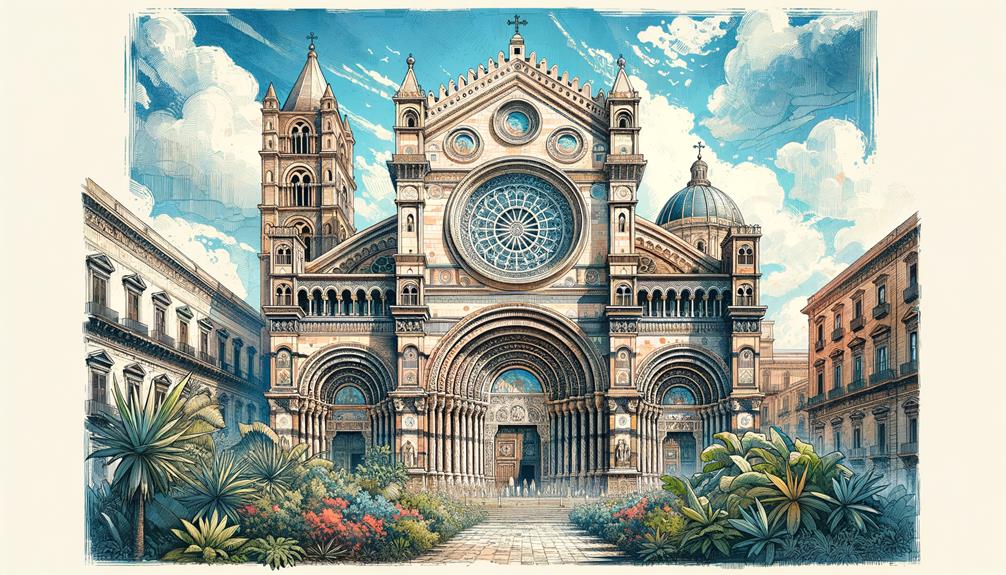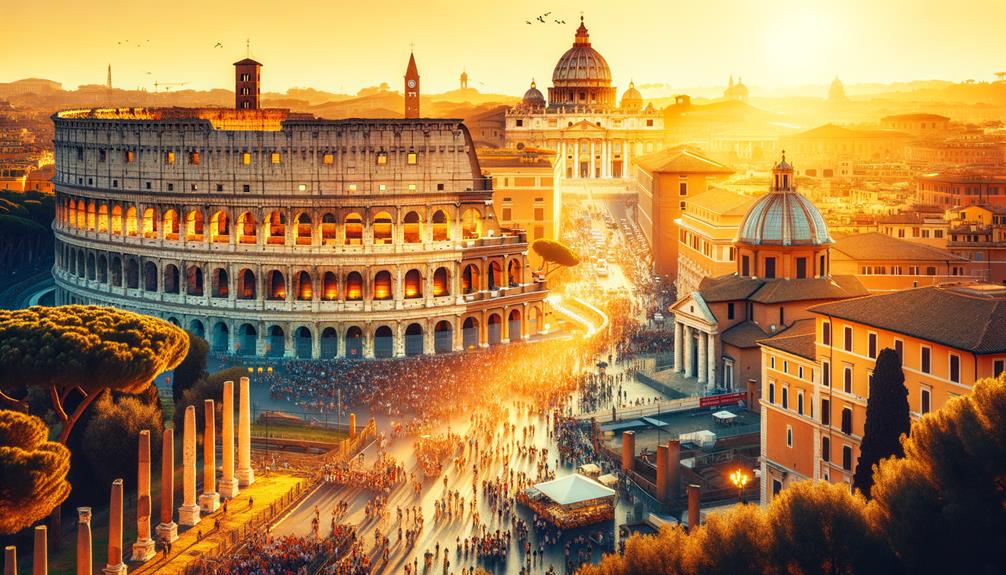Strolling through the stunning Messina Cathedral, I was struck by its Norman-Arab design and the beautiful mosaics that adorn the walls. The Bell Tower, with its incredible Astronomical Clock, showcases scenes from Messina's rich history and mythology, highlighting the city's resilience. The Treasury, filled with historic artifacts, adds another layer of depth to this architectural wonder. With guided tours and audioguides available, there's always more to learn about this storied cathedral. Every detail and artifact invites a closer look.
History of Messina Cathedral
Messina Cathedral has an incredible past filled with resilience and transformation. Walking through its grand entrance, I marveled at how this remarkable structure has survived numerous earthquakes and even a World War II bombing. The Cathedral of Messina, with its imposing façade, is more than just a building; it represents the unyielding spirit of a city that never gives up.
One of the most fascinating features is the Bell Tower, which houses an extraordinary Astronomical Clock. Built in the early 20th century, this clock is not just a timepiece but a marvel of engineering and artistry. Every day at noon, figures emerge, and the clock springs to life, depicting scenes from Messina's history and mythology. Watching it, I felt a connection to the past, a sense of continuity that transcends time.
Standing there, I realized that the Cathedral, the Bell Tower, and the Astronomical Clock are not just historical artifacts; they're symbols of resilience and freedom. They remind us that no matter what challenges we face, the human spirit can endure and thrive.
Architectural Highlights
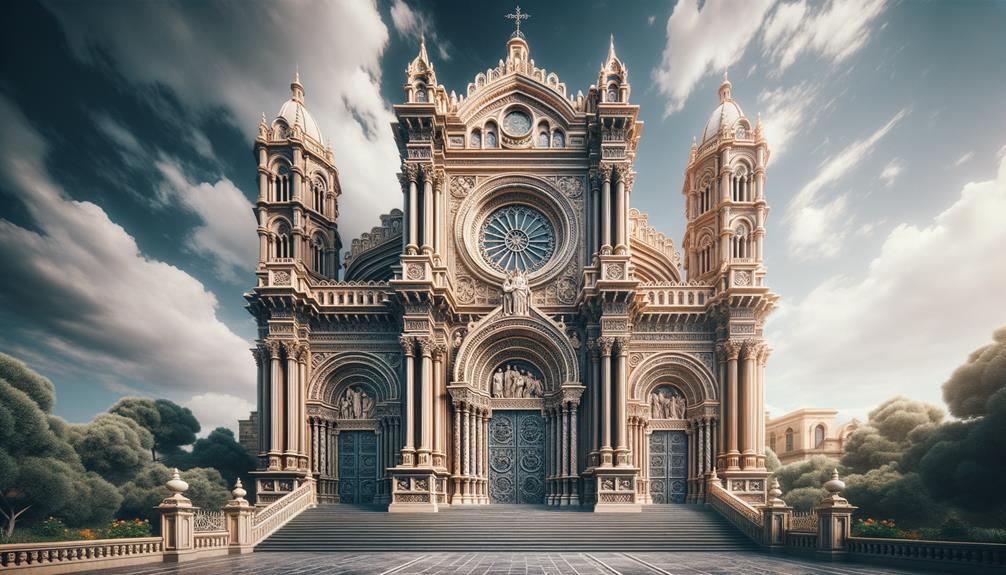
Strolling through Messina Cathedral, I can't help but notice the stunning Norman-Arab design in its arches and columns. The detailed mosaics and frescoes in the apse bowls, commissioned in 1300, still impress with their vibrant colors and craftsmanship. The bell towers and central dome, added after the 1783 earthquake, blend seamlessly with the cathedral's eclectic architectural mix.
Norman-Arab Influence
Walking into the Messina Cathedral, I immediately notice the seamless blend of Norman and Arab architectural features, telling a tale of cultural exchange and historical strength. The cathedral is a stunning example of mixed influences, each adding to its unique beauty and grandeur.
As I explore the space, my attention is drawn to the large dome at the center of the transept, which was added after the 1783 earthquake. This architectural gem highlights the Norman-Arab influence, blending styles in a way that is both flexible and enduring. The marble floor, designed by Giovan Angelo Montorsoli in the 16th century, also showcases this mix, with intricate patterns that reflect the artistic dialogue between Norman and Arab traditions.
- The large central dome: Added after the earthquake, exemplifying the Norman-Arab architectural blend.
- Marble floors by Montorsoli: Detailed and ornate, showcasing cross-cultural artistry.
- Side apses and bell towers: Symbols of adaptation and historical continuity.
Reflecting on these elements, I feel deeply connected to the past. The Messina Cathedral is more than just a structure; it's a testament to the lasting interplay of diverse cultural influences, standing as a symbol of freedom through architectural expression.
Bell Tower Details
The Bell Tower of the Messina Cathedral, with its detailed mechanical and astronomical clock, impresses me with its mix of engineering skill and artistic beauty. Known as the Campanile Orologio di Messina, this tower features the world's largest and most complex clock, expertly created by the Ungerer firm of Strasbourg and unveiled in 1933.
Every day at noon, the clock's mechanism activates, putting on a captivating 12-minute show. Gilded bronze statues on the facade come to life, telling stories from Messina's rich civil and religious heritage. Watching this carefully arranged display of history and craftsmanship feels like stepping into a timeless story.
Visiting the Bell Tower is straightforward and convenient. It's open daily in June, with extended hours on Tuesdays, making it easy to plan a visit. Tickets are affordable, with adult tickets at €5.00 and under-18s at €2.50. There's also a combined ticket for the Bell Tower and the Cathedral's Treasury, offering great value.
Though the tower occasionally closes due to weather, the experience is a memorable mix of history, art, and engineering. Contacting MESSINARTE helps ensure smooth visit arrangements, making every moment at the Bell Tower a cherished memory.
Mosaics and Frescoes
After taking in the Bell Tower's intricate mechanical show, I find myself just as drawn to the cathedral's mosaics and frescoes. These artworks highlight a blend of artistic and cultural influences. Messina Cathedral, with its beautiful mosaics in the apse bowls commissioned by Archbishop Guidotto de Abbiate in 1300, immerses me in a world where art and spirituality meet. These mosaics aren't merely decorative; they tell stories through detailed designs and patterns that reflect the cathedral's Arab-Norman architectural style.
The frescoes, painted by various artists over the centuries, add yet another layer of historical richness. From the Renaissance to the Baroque periods, each brushstroke captures the spirit of its time, creating a vivid timeline of artistic evolution.
- Historic Mosaics: Commissioned by Archbishop Guidotto de Abbiate in 1300, these mosaics showcase medieval craftsmanship.
- Ornate Marble Floor: Designed by Giovan Angelo Montorsoli in the 16th century, the floor enhances the cathedral's overall splendor.
- Cultural Blend: The mix of Arab-Norman styles with Renaissance and Baroque frescoes offers a unique visual feast.
Wandering through Messina Cathedral and taking in its mosaics and frescoes, I feel deeply connected to the past where every corner reveals a piece of history and artistry.
The Bell Tower
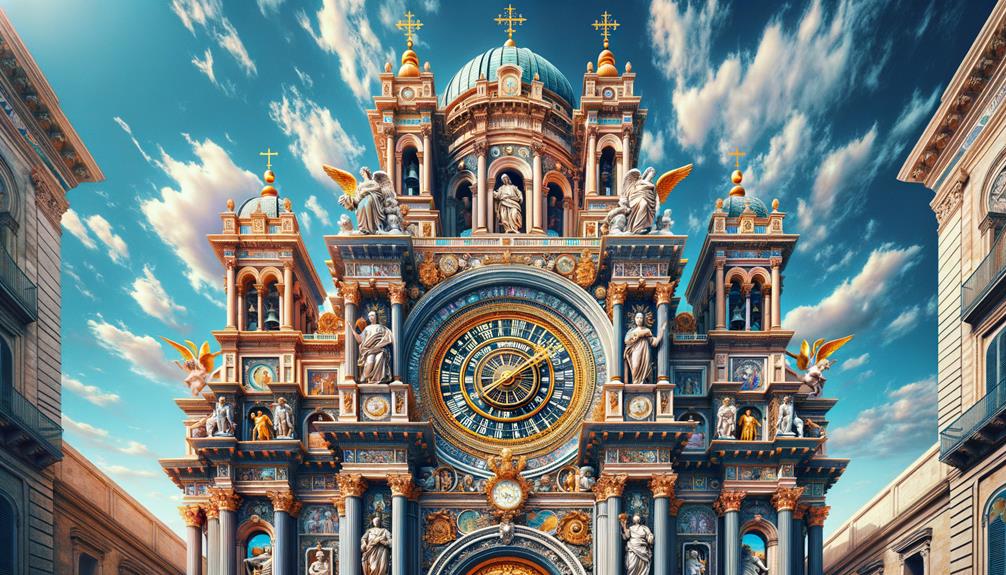
Standing before Messina Cathedral's Bell Tower, you can't help but admire the intricate design and historical significance of its massive mechanical and astronomical clock. Designed by the firm Ungerer of Strasbourg and inaugurated in 1933, this clock showcases human ingenuity and the rich traditions of Messina. Looking up at the gilded bronze statues, you feel a connection to both the civil and religious history of this vibrant city.
The Bell Tower comes alive every day at noon, captivating visitors for 12 minutes with its mesmerizing mechanism. The hours of operation are convenient, making it easy to fit into even a tight schedule. Admission is affordable, making it accessible for families and solo travelers alike.
| Admission Type | Adults (€) | Under-18s (€) |
|---|---|---|
| Bell Tower Only | 5.00 | 2.50 |
| Combined Ticket (Bell Tower + Treasury) | 7.50 | 4.00 |
| Special Opening Hours | 10:00 am – 3:30 pm |
Reflecting on your visit, the blend of art, history, and engineering leaves a lasting impression. The Bell Tower isn't just a timepiece; it's a story of Messina's resilience and creativity. Despite occasional weather closures, the experience is well worth it, adding a unique chapter to any traveler's journey.
Astronomical Clock Features
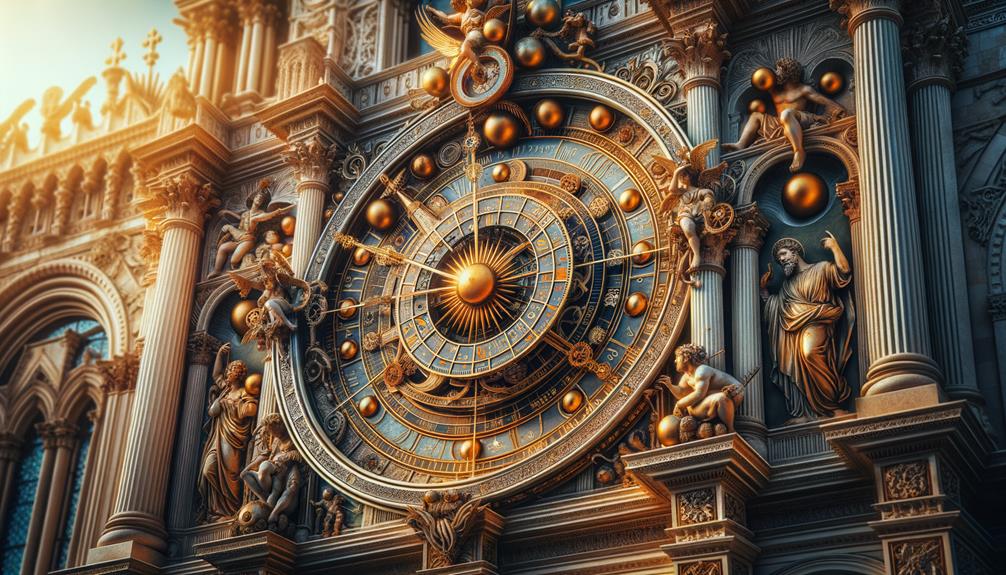
Looking up at the Astronomical Clock at Messina Cathedral, I'm amazed by its blend of art and science. This clock isn't just for telling time; it's a testament to human creativity and skill. Every feature has its own story and purpose.
The clock's face is a detailed display of celestial movements, showing the paths of the sun, moon, and stars. It's like holding the universe in your hands, with each gear and dial working seamlessly. The golden details catch the light, making the whole clock shine beautifully.
- Zodiac Signs: The zodiac wheel rotates daily, highlighting each astrological sign.
- Lunar Phases: A smaller dial shows the moon's phases with precision.
- Planetary Positions: Another part displays the positions of known planets.
Standing there, I realize this clock isn't just about time—it's about our connection to the universe. Messina Cathedral's clock reminds me that even in our digital age, there's something special about a masterpiece that merges science with art, earth with sky.
Bronze Statues
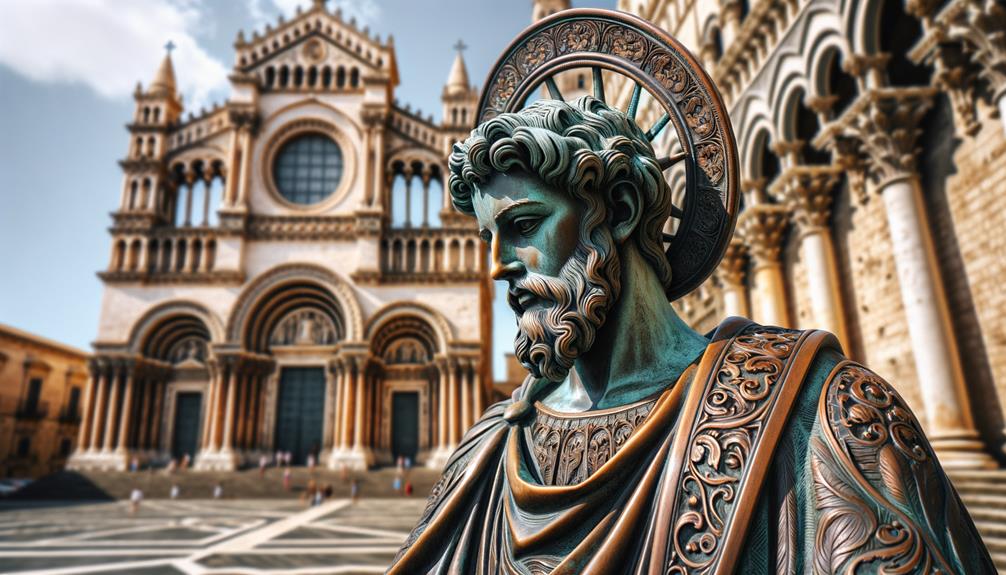
As I stand in front of the bronze statues, I feel a strong connection to the past. The detailed craftsmanship of each piece tells its own story, showcasing the skill of the artists from that time. It's amazing to think about the historical importance these statues hold within the cathedral's history.
Historical Significance
The bronze statues around Messina Cathedral aren't just for show; they quietly recount the building's rich history. Walking through the cathedral, you can almost feel the weight of the centuries. Each statue, with its fine details and serious expressions, tells a story of Messina's turbulent past, filled with resilience and renewal.
Reflecting on their historical significance, a few key points come to mind:
- Strength in Hard Times: The cathedral has faced earthquakes, wars, and numerous rebuilds. These statues have stood through it all, symbolizing the strength and perseverance of Messina's people.
- Silent Guardians: Positioned thoughtfully, they serve not only as art but also as protectors, reminding visitors of the cathedral's sacred and historical value.
- Cultural Heritage: Each statue represents a piece of Messina's cultural history, from religious icons to historical figures, capturing the essence of different periods.
These statues are much more than decorations; they're tangible links to the past. They invite us to stop and think about the layers of history within Messina Cathedral, offering a deeper appreciation of its lasting legacy.
Artistic Details
Walking up to the Bell Tower, I was struck by the intricate bronze statues that are key to the clock's mesmerizing mechanism. These gilded figures, rich in civil and religious traditions, stand proudly on the facade, captivating onlookers with their detailed craftsmanship. Every day at noon, they come to life in a fascinating 12-minute performance.
During my private guided tour, I discovered that these statues are not just ornamental but essential to one of the largest and most complex mechanical and astronomical clocks in the world. The clock, designed by the renowned Ungerer firm of Strasbourg and inaugurated in 1933, showcases 20th-century clock-making artistry. Watching the statues move, I felt a deep connection to Messina's cultural heritage, each movement narrating a piece of the city's past.
The meticulously designed bronze figures add significantly to the Bell Tower's artistic charm. Their daily dance pays tribute to human ingenuity and artistic expression. This tour offered an intimate look at the intersection of art, history, and engineering—a truly liberating experience that celebrates the timeless beauty of Messina.
Mechanical Systems
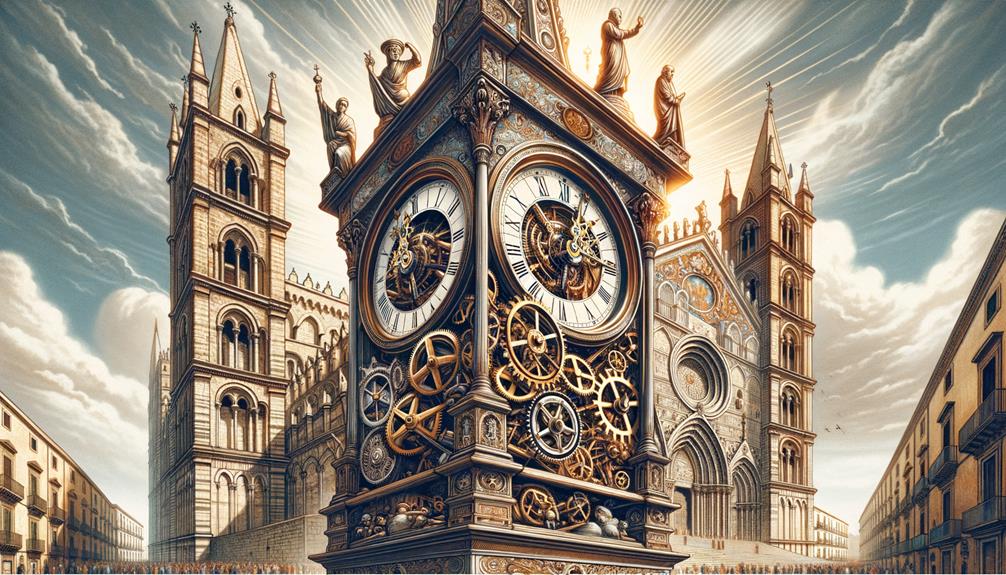
One of the most captivating features inside Messina Cathedral is the intricate mechanical system of its astronomical clock. Visitors are mesmerized by its detailed movements and historical significance. On a guided tour through the cathedral, I was drawn to the clock's elaborate design. The engineering behind it is a marvel, blending artistry and precision in a way that feels almost magical.
- The lion roars every day at noon, kicking off a spectacular display.
- Golden figures parade, representing different stages of human life.
- Celestial movements track the phases of the moon and the positions of the planets.
Standing there, I was in awe of the ingenuity of those who designed and built this masterpiece centuries ago. The clock doesn't just tell time; it tells a story, combining science, art, and history. Each component works in harmony, creating a living tapestry of movement and sound. The mechanical systems of Messina Cathedral are a testament to human creativity and our desire to understand and represent the cosmos in all its complexity.
Treasury of the Cathedral
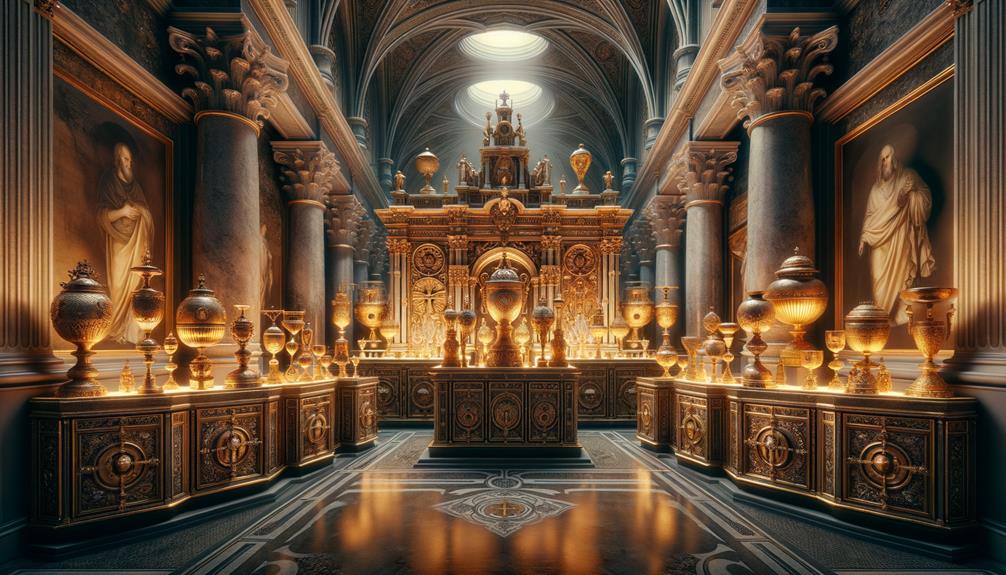
Entering the Treasury of the Cathedral, I immediately felt a deep sense of wonder at the collection of historic artifacts. The religious relics on display, each with its unique story, seemed to bring history to life. Among the architectural highlights, the detailed monstrances stood out, showcasing the impressive skill and dedication of their creators.
Historic Artifacts Collection
The Treasury of the Cathedral, located in the sacristy, impresses with its extensive collection of historic artifacts like precious jewels, ornate reliquaries, and sacred vestments. I was immediately struck by the luxury and historical importance of each piece as I explored this incredible collection in Messina. The guided tour, offered in several languages, deepened my appreciation by uncovering the intricate details and stories behind these relics.
- A 12th-century Byzantine crucifix, striking in its ancient beauty.
- A 14th-century Gothic reliquary, showcasing medieval craftsmanship.
- A 16th-century Flemish tapestry depicting the Life of the Virgin, vibrant and meticulously detailed.
Each artifact seemed to tell a story from the past, highlighting the reverence and artistry of earlier times. The Treasury's collection is more than just a display; it's a journey through history, where each item reveals a piece of Messina's spiritual and cultural heritage. Reflecting on the ornate tapestries and embroidered fabrics, I was amazed by the skill and devotion required to create these masterpieces. The Treasury of the Cathedral is truly a hidden gem, waiting to be explored.
Religious Relics Display
As I walked through the Treasury's sacred halls, I couldn't help but be amazed by the incredible collection of religious relics. Among them were a piece of the True Cross and a thorn from Christ's Crown. The Museo Tesoro del Messina Cathedral is home to these revered items, each filled with centuries of history and devotion.
Strolling through this space, I pondered the deep meaning these objects hold for so many people. The reliquary with a fragment of the Virgin Mary's veil was especially striking—a fragile piece displayed during special events. Each relic seemed to tell stories of faith, dedication, and the passage of time.
The calm atmosphere of the Treasury encouraged reflection. I felt a strong connection to history, as if the walls themselves were protecting these sacred items. The entrance fee of €7.50, which also includes access to the Bell Tower, seemed a small price for such a rich experience. Discounts for younger visitors and group tours make this journey into history accessible to many.
Open daily in June with longer hours on Tuesdays, the Treasury of the Cathedral is a must-visit for anyone interested in the depth of religious heritage in Messina.
Architectural Masterpieces Showcased
As I wandered through the Treasury, the lavish design of the rooms immediately caught my eye. Intricate frescoes and mosaics framed each valuable artifact, their vibrant colors and detailed patterns telling stories of Messina's rich history. These artworks added depth and meaning to the treasures they surrounded.
Walking through the Treasury, I was captivated by the beauty and historical importance of the collection. Golden crowns gleamed under soft lighting, ornate chalices sparkled, and embroidered vestments showcased the craftsmanship of past eras. Each room was more enchanting than the last, making this part of the tour unforgettable.
- 12th-century golden reliquary: A stunning example of medieval artistry, reflecting the religious devotion of its time.
- 15th-century silver crucifix: Exquisite detail that highlighted the skill of Renaissance metalworkers.
- 17th-century Flemish tapestry: Rich in color and texture, telling a tale of cultural exchange.
This walking tour, whether guided or private, offers a unique glimpse into Messina's storied past through these architectural masterpieces. The Treasury is not just a collection of artifacts; it's a journey through time.
Visiting Hours
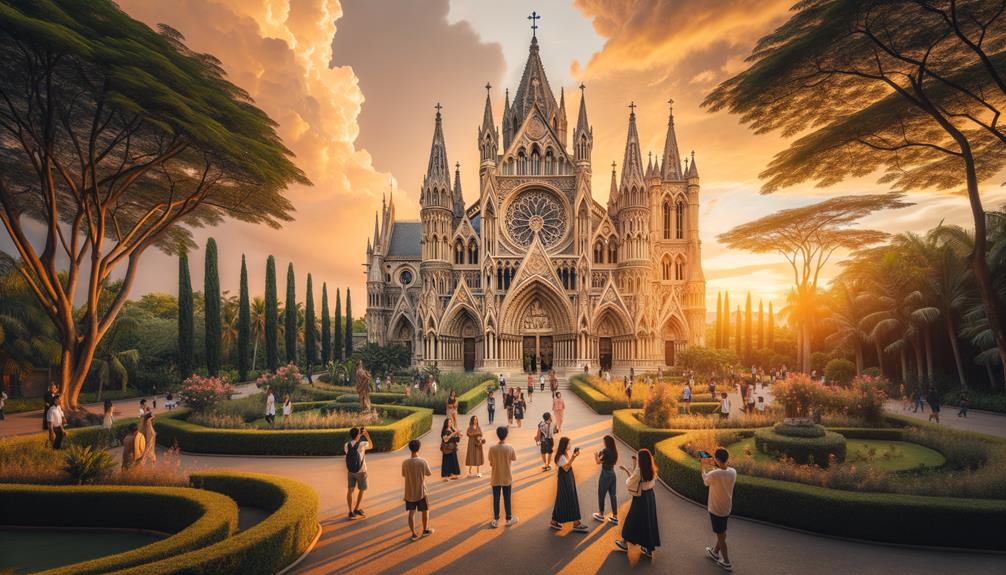
You can visit the Messina Cathedral every day from 7:30am to 12:30pm and 4:00pm to 7:00pm. The cathedral opens its doors daily, offering a space where history and spirituality blend seamlessly. Early morning visitors can enjoy the calm light filtering through the stained glass, while those who come in the evening can witness the soft glow of twilight casting shadows on the ancient stone.
If you're looking for a deeper experience, weekday masses are held at 7:30am and 6:00pm. On Sundays and religious holidays, services take place at 8:30am, 10:30am, 12:15pm, and 6:00pm. It's a good idea to check the MessinArte website for the latest schedule before you go, as times can change.
Getting into the cathedral is straightforward, but for a richer experience, I recommend the €4.00 audioguide, which offers detailed insights into the cathedral's history and art. If you prefer a more personalized experience, guided tours in Italian, English, French, and Spanish are available by reservation. Reflecting on my visit, I felt a profound sense of freedom in exploring this timeless space, where each visit offers a new perspective on its enduring beauty.
Group Reservations

Planning a group visit to Messina Cathedral is easy when you contact MESSINARTE for reservations. Just call +39 090675175 or email info@messinarte.it or messinarte@tiscali.it to arrange a memorable experience for your group. The minimum group size is 25 people, ensuring a personalized and intimate tour for everyone.
MESSINARTE simplifies the process of including the Bell Tower and Treasury in your tour. For a combined ticket price of €7.50 for adults and €4.00 for those under 18, your group can explore these fascinating parts of the Cathedral.
When making reservations, be sure to book at least one week in advance. This guarantees availability and allows for any special arrangements, such as discounts for large groups or school outings. Here are a few key points to remember:
- Simple booking: Contact via phone or email.
- Inclusive tours: Bell Tower and Treasury included.
- Special offers: Discounts for large groups and schools.
A Private Tour of Messina Cathedral becomes even more rewarding when you plan ahead and take advantage of the available resources.
Special Dates and Events
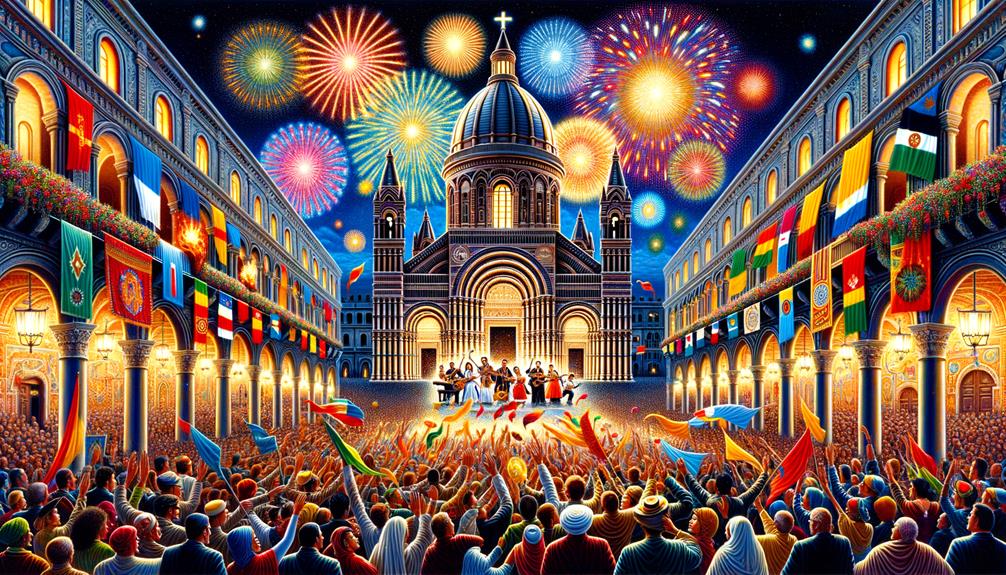
Mark your calendars for the special events at Messina Cathedral that bring the city's rich history and vibrant traditions to life. One of the most captivating experiences is watching the Bell Tower's intricate mechanical and astronomical clock in action. Every day at noon, the gilded bronze statues come to life for 12 minutes, showcasing scenes from Messina's civil and religious heritage. It's a must-see spectacle.
In June, the Bell Tower is open daily from 10:00 am to 1:00 pm, with extended hours on Tuesdays and select dates. If you're planning a visit, groups of 25 or more need to arrange access in advance. Admission is quite reasonable: €5.00 for adults and €2.50 for those under 18. For a more extensive experience, consider the combined ticket for the Bell Tower and the Treasury of the Cathedral, priced at €7.50 for adults and €4.00 for under-18s.
Be aware that the Bell Tower might close unexpectedly due to bad weather. Managing your preferences and consenting to cookie usage on the MESSINARTE website will streamline your visit. For more details, contact MESSINARTE at +39 090675175 or via email at info@messinarte.it.
Frequently Asked Questions
Is Messina Walkable From Cruise Port?
Yes, you can easily walk from the cruise port to the heart of Messina. It's just a short 10-15 minute walk through the historic center, where you can enjoy the city's rich history and architecture along the way.
Is Messina Worth Seeing?
Messina is definitely worth a visit. Strolling through its historic center, taking in both medieval and modern architecture, and enjoying lively festivals, I felt a strong connection to its rich culture and beautiful coastal views.
How Do You Spend a Day in Messina?
How would I spend a day in Messina? I'd kick things off with a private walking tour to soak in the city's history and charm. After that, maybe a boat trip to Giardini Naxos for some coastal views. To wrap up the day, I'd climb the Bell Tower for a breathtaking panorama. Can you picture it?
What Is the City of Messina in Sicily Known for at the Norman Cathedral?
Messina, a city in Sicily, is famous for its beautiful Norman Cathedral. The detailed mosaics and the astronomical clock are a sight to behold. As I explore, I feel a deep connection to the rich history and artistry that spans centuries.

